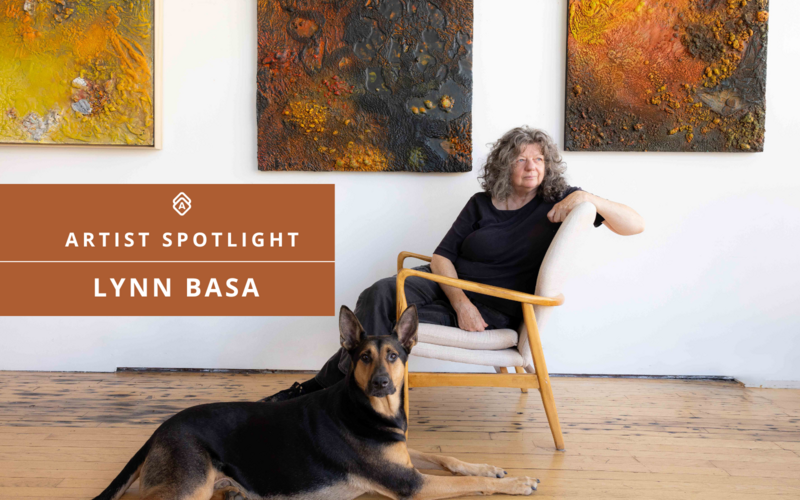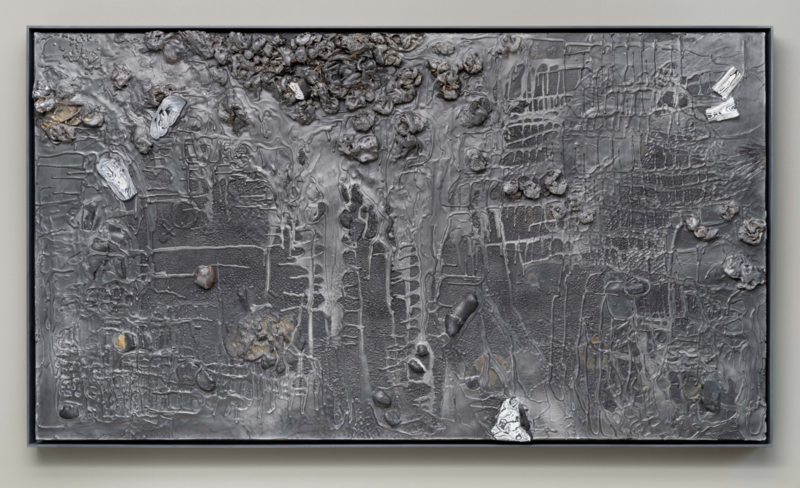"My process is mostly a mess, until somehow it reaches a point where it all makes sense."
As a full-time artist working out of a former Polish sausage shop in Chicago's northwest side, Featured Artist Lynn Basa balances painting, ceramic sculpture, and public art.
Her work isn't necessarily "beautiful", at least not in the traditional sense. It's scarred, imperfect, and full of life—echoing the human experience in all its messy glory. It’s no surprise that her process is as intuitive as it is unflinching. “It’s mostly a mess,” she says, “until somehow it reaches a point where it all makes sense. Not necessarily beautiful, still scarred and awkward, but ready to go out into the world. It is autobiographical.”
In addition to her studio practice, Lynn Basa takes on large-scale public art commissions and is the founder of The Corner Project—a community development initiative to revive three blocks of a vintage, working-class main street just outside her studio door. Through storefront transformations, murals, and persistent advocacy, she’s proof that an artist can be both a maker and a caretaker of place.
Whether working with hot wax in her studio or helping reshape the social fabric of a neighborhood, Lynn Basa’s practice is one of surrender, excavation, and emergence. It’s a body of work shaped by memory and marked by a willingness to embrace what happens in the mess.
Artwork Archive had the chance to chat with Lynn Basa about her creative process, why she makes her work "unsellable" and how Artwork Archive is her go-to tool.
You can see more of her work on Discovery and learn more about her art practice below:
Lynn Basa, Morphium, 40 x 72 x 2 in, 2024
The Highs and Lows of Lynn Basa’s Creative Journey
When asked about her diverse artistic practice, Lynn Basa didn’t hold back. She candidly shared the emotional ups and downs that come with working across different mediums.
"My creative process with painting and public art is agonizing," she openly confessed. "Painting often feels like I'm wrestling with myself." Yet, as she described her experience with ceramics, the tone changed: "The work flows out of me. It feels like play—maybe it's because wet clay doesn't leave time for second-guessing. It’s instinctive and immediate."
Why She Makes Her Work "Unsellable"
Reflecting on her long-time “obsession with time and memory”, Basa told Artwork Archive how these themes unexpectedly revealed themselves. "Since I made that comment, I've grown in understanding my work. I now know what all of the digging through layers is about,” she reflected. "It’s about the secrets and the things unsaid beneath the surfaces we present to the public."
A particularly influential moment for Lynn Basa came from a tough but valuable critique.
"Someone I deeply respect told me I needed to stop worrying about what others think of my work—especially whether it would sell," Basa shared. This advice sparked a powerful perspective shift—one that inspired her to explore beyond the boundaries she'd subconsciously created. Driven by this newfound freedom, the artist began experimenting with a provocative question each time she began a new piece:
"I ask myself: Is this ‘unsellable’? If the answer is 'No,' then I mess it up to the point where it is," she said. "It was incredibly freeing—I pushed myself to an extreme I hadn't explored before, and now I'm excited to see how much further I can go."
Her experience serves as a powerful reminder to us all about the rewards that can come from challenging conventional ideas of perfection and marketability, and trusting in our own authentic voice.
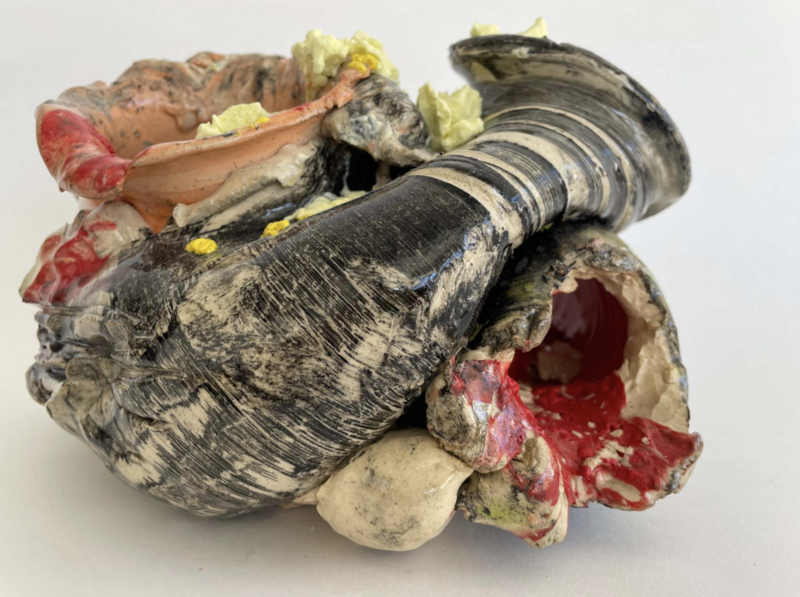
Lynn Basa, Remains #8, 6 x 9 x 9in, 2025
The Challenge of Public Art
With an MPA in public art policy, Lynn Basa has spent plenty of time thinking about how art lives in public spaces. Still, that doesn't make it easy. "Public art is a struggle for me," she confessed.
In her studio, Basa has learned to let go of worrying about what others might think of her work. But in the public realm, that freedom doesn’t quite carry over. “Unlike my recent revelation in the studio of letting go of what others will think of my work, there's no escaping that with public art,” she explained. “It's all about how the art will affect other people.”
But, the artist is working to find her way through it, aiming to bring the same organic, spontaneous energy that fuels her studio practice into her public work. It’s not easy, but it’s honest. And for those of us trying to navigate that same push-pull between inner voice and outer impact, her words hit home.
Silencing the Inner Critic
For this artist, one of the most unexpected—and persistent—challenges of being a professional artist hasn’t been the logistics of running a business or the administrative side of the job. “By far, it’s been figuring out how to ignore the voices in my head about what people will think about the work,” she shared.
It's a sentiment that rings true for so many of us—that ever-present inner critic that can show up at any stage of the process, whispering doubts, raising questions, and making it hard to just... make. Over the years, Basa has tried just about everything to quiet those voices. One trick that has helped? Her mindset shift mentioned earlier: intentionally making a piece "unsellable".
That small rebellion gives her the freedom to stop worrying about how her work will be received and start focusing on what it needs to be.
“The business of being an artist is nothing compared to the creative struggle because there's a well-trodden path,” Basa explained. In other words, organization and marketing plans may be overwhelming—but at least they come with guides. The emotional terrain of creative work, on the other hand, is deeply individual. “To paraphrase Tolstoy,” she added, “each struggling creative is struggling in their own way.”
While that struggle may be personal, it's far from rare—and Lynn Basa has learned that sometimes, making peace with it is its own form of progress.
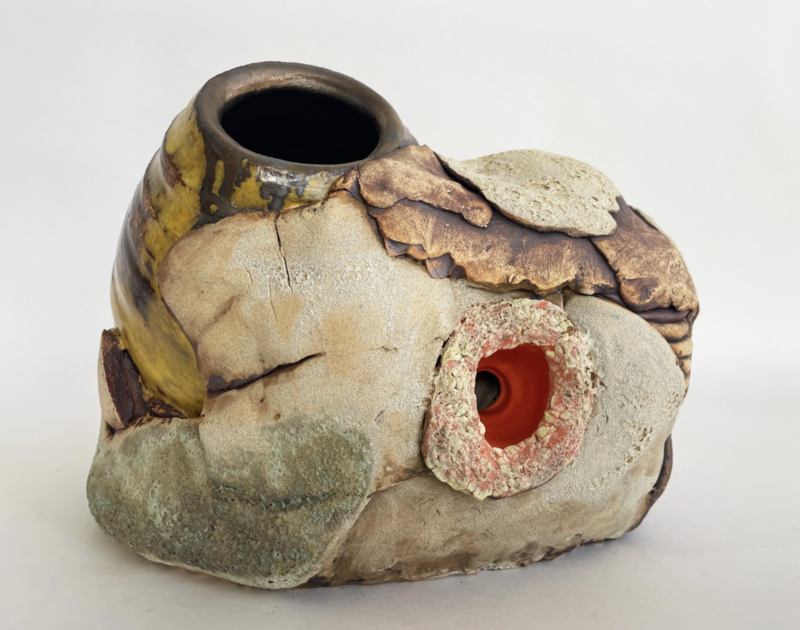
Lynn Basa, Yellow Fossil Jar, 2024
Daily Rituals in the Studio
Lynn Basa's studio routine doesn't follow a rigid structure. Rather, it flows, guided by a sense of comfort, presence, and a little help from her very important studio assistant. “As soon as my dog Rambo and I walk into the studio, we click into studio mode,” she shared. Rambo claims his post on the sofa, where he can keep an eye on the world outside, while Basa eases into the day beside him.
But early on, she struggled with how that routine looked. Mornings are often quiet—spent sipping tea, catching up on emails, scrolling through Instagram, and waiting for the wax to melt. “I fritter away a couple of hours,” she admitted. “By then it’s time for lunch.”
And for years, that slow start came with a side of guilt. Basa thought she should be putting in eight focused hours of creating each day—like a “real” working artist. But over time, that pressure gave way to a more honest understanding of how her creativity actually works.
“I finally realized that the time artists spend not working—the negative space, as I think of it—is critical to the creative process,” she said.
Because by the afternoon, things shift. “I turn on bossa nova (or a true crime podcast) and get into the flow,” she explained. The art still gets made. But now, this professional artist gives herself the space to arrive at it in her own way.
Finding Artwork Archive
Before discovering Artwork Archive, Lynn Basa was deep in the weeds of an all-too-familiar artist dilemma: managing a growing inventory with a chaotic Excel spreadsheet. “It became an incomprehensible mess as my practice grew,” she recalled.
The turning point came when she brought on a studio manager and handed over the impossible task of wrangling her scattered records. “I had a wonderful studio manager who I tasked with finding a better method,” Basa explained. That better method turned out to be Artwork Archive.
It took a few days to input all the scattered information, but once it was in, things changed—and the payoff was immediate. "After we set up my Artwork Archive account, my studio manager was able to find $20k that was owed to me from work that was sold but that I had lost track of collecting payment," Basa shared. “She was able to get all of that back for me.”While her studio manager eventually moved on, Lynn Basa didn't go back to spreadsheets.
"Because of how Artwork Archive is set up, I don't need an employee dedicated to inventory tracking now," Basa exclaims. "I can do it myself."
For any artist who's ever felt buried under the admin side of their practice, Lynn’s story is a reminder: getting organized can bring a real relief—and it can (sometimes very literally) pay off.
Feeling Behind on Inventory? Start Here:
Adding your entire art inventory into Artwork Archive might take a few sessions—and that's totally okay. Start with your most recent work, carve out 1-2 afternoons a week, and work backward. Give yourself some grace along the way.
Need a shortcut? Our team offers a free import service to help you get organized faster.
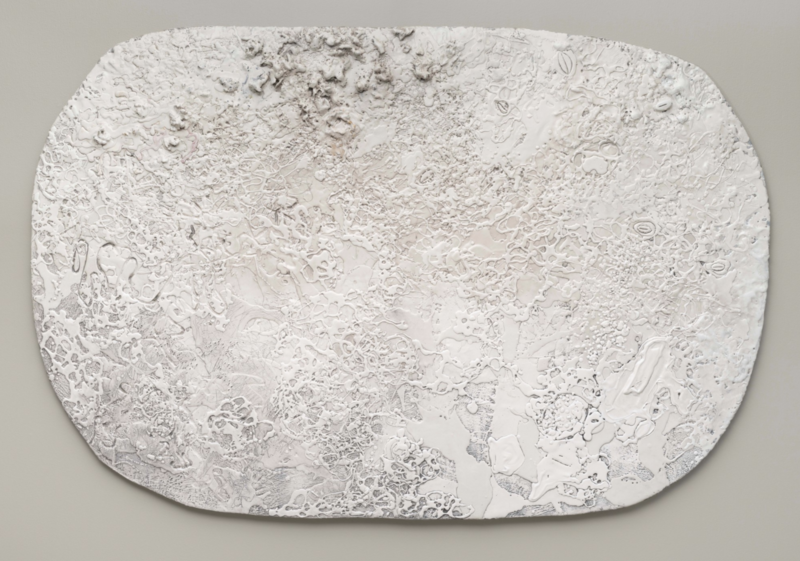
Lynn Basa, Smatterings, 45 x 68 x 1.5 in, 2023
Favorite Features
Lynn Basa works primarily with art consultants, so when they reach out asking to see more work—often with little notice—she needs to move fast. That’s why one of her favorite features of Artwork Archive is how quickly she can generate polished Portfolio Pages. “I can print out Portfolio Pages within five minutes of a client asking to see specific work,” she said.
That kind of speed has made a real difference in how her professionalism is perceived. “There have been more times than I can count when a client told me how much they appreciate my professionalism", the artist shared. Even when a sale doesn’t happen immediately, she knows the impression sticks. “At least they know I’m ready when they’re ready to make the sale,” she said.
For artists juggling last-minute requests and trying to stay on top of it all, that kind of confidence and preparedness can go a long way.
Tools That Make You Look Put-Together (Even When You're Not):
Portfolio Pages are just the beginning. Artists also love using Private Rooms for custom client previews, Public Profiles to boost their online presence, and Inventory Reports to stay ready with answers—whether they’re working with consultants, collectors, or galleries.
Emerging Artists: Do THIS Early:
When asked what she’d tell artists at the beginning of their careers, Lynn Basa didn’t hesitate: get organized early.
“If you're just starting out, it's the perfect time to set up your Artwork Archive inventory,” she said. She’s seen firsthand how much harder it is to play catch-up later—and how easy it is to lose track of important details if you're relying on memory or messy systems.
Basa knows plenty of artists who’ve resisted investing in a platform like Artwork Archive because they think their spreadsheets are good enough. “They say they've got good records on spreadsheets and compile a PDF for each client inquiry,” she explained. But here’s the thing: when a client reaches out, time matters. “It takes them hours to put together those PDFs—when it takes me five minutes with Artwork Archive," she said. "Those are hours you could spend making art."
She also stressed the importance of staying on top of your records in real time. “Every time you make a new piece, send one out on loan, have one on reserve—do not hesitate to immediately record it,” she advised. “Don't fool yourself into thinking that you'll remember to do it later.”
Her final words were simple, but they stuck: “If you're good to Artwork Archive, it'll be good to you.”
Whether you’re just starting out or years into your practice, Lynn Basa’s advice is a solid reminder that a little organization now saves a lot of stress later—and gives you more time to focus on the work that really matters.
You can make an online portfolio, catalog your artwork, and generate reports like inventory reports, tear sheets, and invoices in seconds with Artwork Archive. Take a look at Artwork Archive's free trial and start growing your art business.
